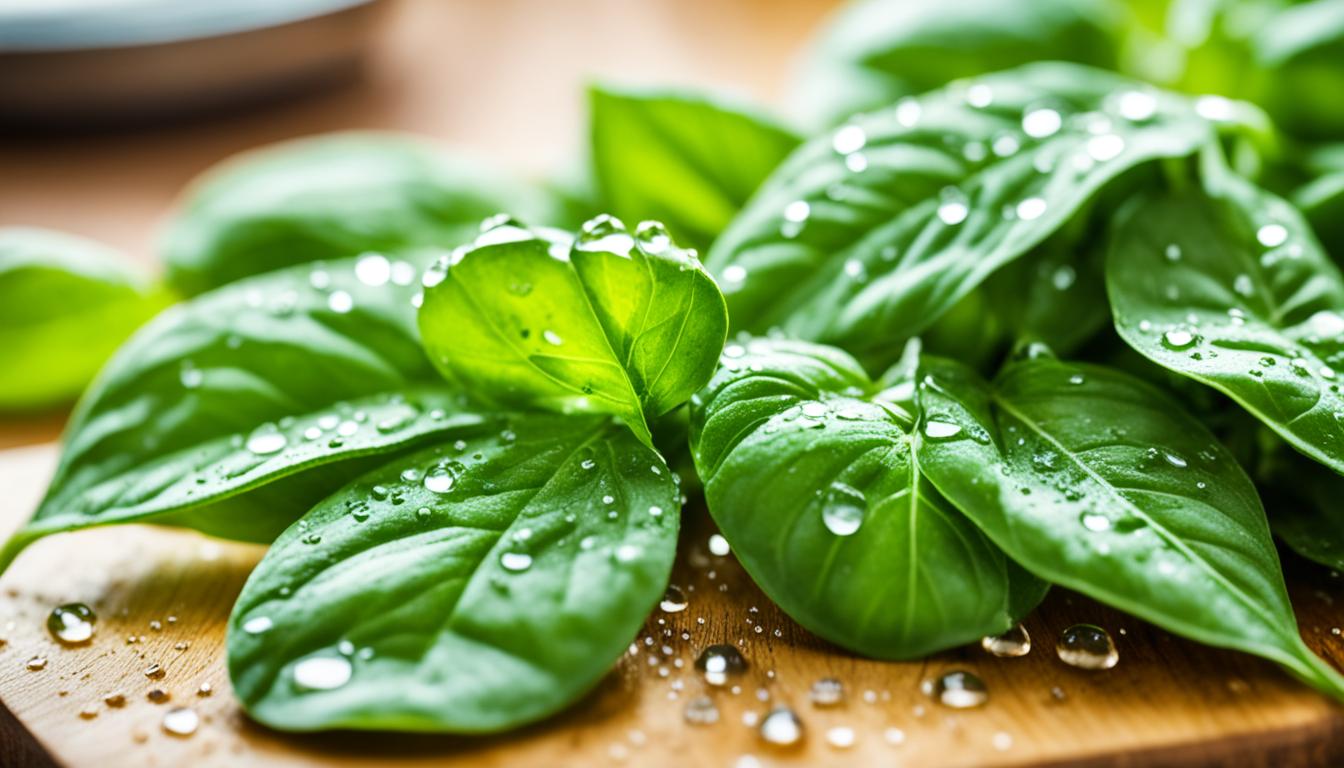I love cooking and basil is a favorite of mine. It has a great smell and can make many dishes taste better. From pasta sauces to salads and even desserts, basil adds something special.
Basil comes from Asia and Africa and has been grown for over 5,000 years. It’s part of the mint family. This herb is key in many dishes, like Italian cuisine.
It’s famous for its role in pesto alla Genovese and Thai basil. Basil is not just tasty but also good for you. You’ll find lots of ways to use it in your cooking here.
The History and Origins of Basil
Basil is a fragrant herb that has been around for centuries. It comes from ancient Asia and Africa. People have grown and loved it for thousands of years.
In ancient Egypt, people first used basil for medicine and in religious rituals. Then, it spread to the Mediterranean. There, it became a key part of Greek and Roman cooking.
From Ancient Times to Modern Cuisine
As Mediterranean cultures grew, so did basil. It moved to Italy, becoming a big part of Italian food. Now, basil is a symbol of Italian cooking, going from old kitchens to new ones.
Basil’s story shows how much people love and use it. From its old roots to today’s kitchens, it keeps amazing chefs and food lovers.
“Basil is not just a herb, it’s a way of life.”
Basil: A Culinary Gem
Basil’s flavor is a mix of sweet, peppery, and fresh notes. This makes it a top choice for many dishes. It goes well with salads, pasta, and even sweet treats. Basil’s special taste comes from compounds like estragole and linalool.
This herb has a sweet and peppery taste. Its fresh smell adds depth to any dish. Basil fits well in many recipes, from savory to sweet dishes.
There are many ways to use basil in cooking. It can make salads, pasta, pesto, and even desserts better. Its spicy taste goes well with creamy sauces. Its smell can make simple dishes taste fresh.
Basil is also great for making flavored oils and vinegars. These can add flavor to many meals.
| Basil Flavor Profile | Culinary Applications |
|---|---|
| Subtle sweetness | Salads, pasta dishes, pesto |
| Peppery notes | Creamy sauces, tomato-based dishes |
| Refreshing aroma | Infused oils and vinegars, baked goods |
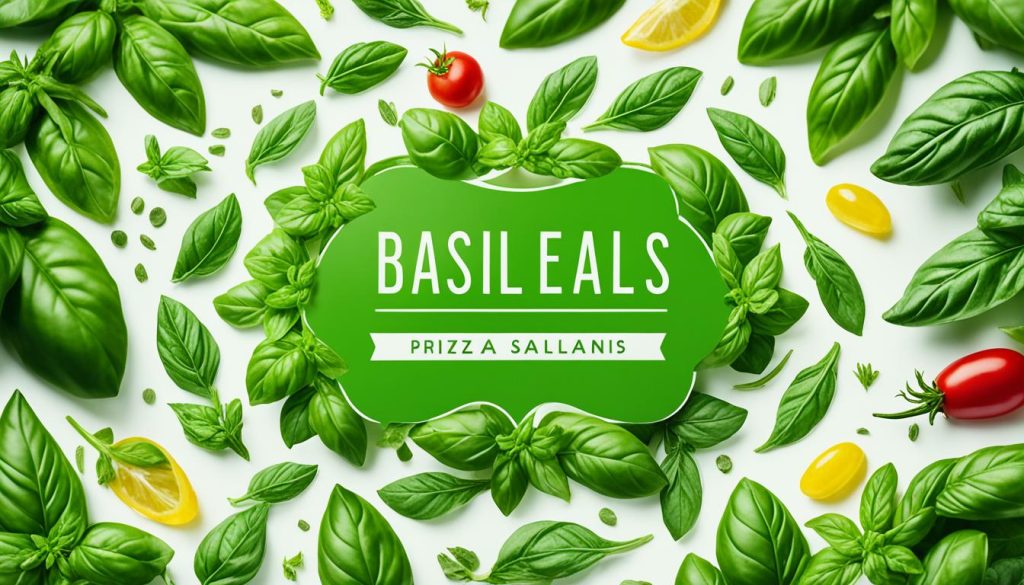
“Basil is the culinary chameleon, effortlessly adapting to a wide range of flavors and culinary applications.”
Varieties of Basil: A World of Flavors
Basil is a versatile herb with many types, each with its own unique taste. Over 35 varieties and more than 160 cultivars exist. A few are especially great for cooking.
Genovese: The Classic Italian Favorite
Genovese basil has a sweet anise flavor and a sweet clove-like smell. It’s a beloved classic in Italy. It’s often used in tomato sauces and fresh salads.
Its bright green leaves and soft texture are perfect for pesto and other basil dishes.
Thai Basil: Exotic and Spicy
Thai basil has a unique licorice flavor with a bit of spice. It’s a key herb in Southeast Asian cooking. It adds an exotic touch to curries and stir-fries.
The leaves and stems of Thai basil are purple-tinged, making it a beautiful addition to dishes.
| Variety | Flavor Profile | Culinary Uses |
|---|---|---|
| Genovese Basil | Anise, sweet clove | Tomato sauces, pesto, salads |
| Thai Basil | Licorice, spicy | Curries, stir-fries, Southeast Asian dishes |
“Basil is the king of herbs, the most regal of the mint family. It is the herb most entwined with the romance and warmth of the Mediterranean.”
Growing Basil at Home
Growing your own basil at home is rewarding and tasty. Basil loves warm, sunny spots and soil that drains well. With a few easy tips, you can pick a lot of this tasty herb from your garden.
Cultivation Tips for a Bountiful Harvest
Start by picking a sunny spot in your garden that gets 6-8 hours of sunlight daily. Basil does best in soil that’s a bit acidic, with a pH of 6-7. Add compost or well-rotted manure to your soil for extra nutrients.
- Plant basil seeds or seedlings after the last frost, as this herb thrives in warm weather.
- Space the plants about 12-18 inches apart to allow for proper air circulation and prevent disease.
- Regularly water your basil, keeping the soil consistently moist but not waterlogged.
- Pinch back the stems regularly to encourage bushier growth and prevent the plant from bolting and going to flower.
- Protect your basil from pests by using organic methods, such as companion planting with marigolds or applying a neem oil spray.
By following these simple tips for growing basil, you’ll be on your way to a thriving basil garden. Enjoy the fresh, aromatic harvest all season long.
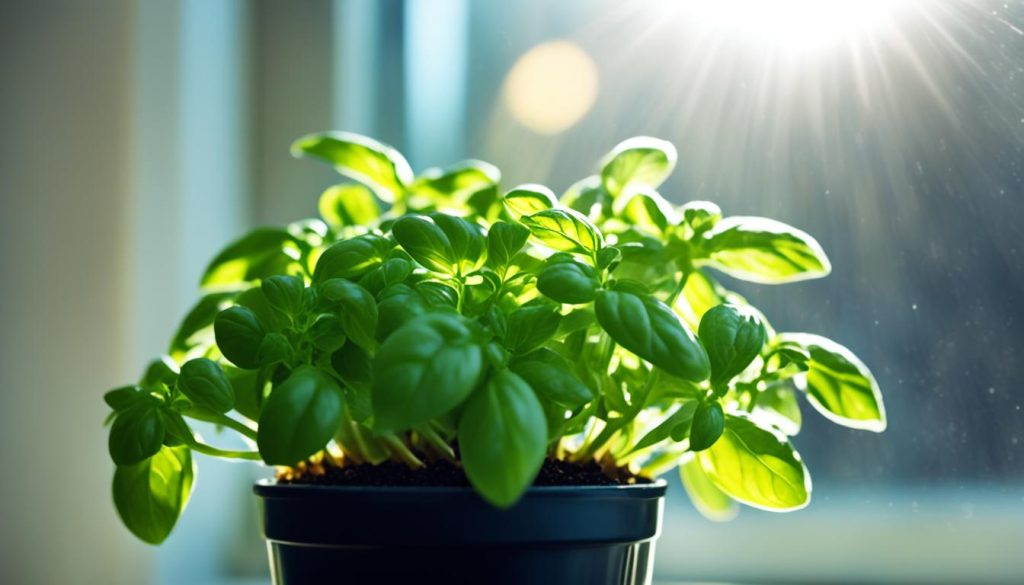
Basil in the Kitchen
Basil is a versatile herb that can be used in many dishes. It adds a fresh and herbaceous touch to food. Whether you’re making classic pesto or trying new recipes, basil is a great choice.
Recipes and Cooking Techniques
Basil is not just for pasta with tomatoes. It can be used in baked goods, infused oils, and as a garnish. By trying different cooking methods, like chopping or adding whole leaves, you can bring out basil’s best flavors.
One famous way to use basil is in Italian pesto. This sauce is great with pasta, on bread, or as a meat or veggie marinade. Feel free to mix it up by using different nuts or cheese.
Basil is also great in salads. Combine it with tomatoes, avocado, and balsamic vinaigrette for a light summer salad. You can also add it to soups, stir-fries, and even baked goods like basil-infused bread or scones.
| Basil Culinary Uses | Cooking Techniques |
|---|---|
| Pesto | Chopping |
| Salads | Tearing |
| Soups and Stir-fries | Whole Leaf |
| Baked Goods | Infusing Oils |
| Garnishes | Marinating |
Exploring how to cook with basil opens up new culinary possibilities. It lets you add a unique flavor to your dishes.
Health Benefits of Basil
Basil is more than just a tasty herb. It’s full of vitamins, minerals, and compounds that boost your health. This plant is a treasure for your well-being.
Basil is full of antioxidants. It has eugenol, citronellol, and linalool. These help fight inflammation and bacteria. Eating basil can help your digestion, boost your immune system, and keep your heart healthy.
Nutritional Powerhouse
Basil is a great source of vitamins and minerals. It’s packed with vitamin K, which is key for blood clotting and strong bones. It also has vitamin A, vitamin C, and B vitamins. These help keep your immune system strong and your body running well.
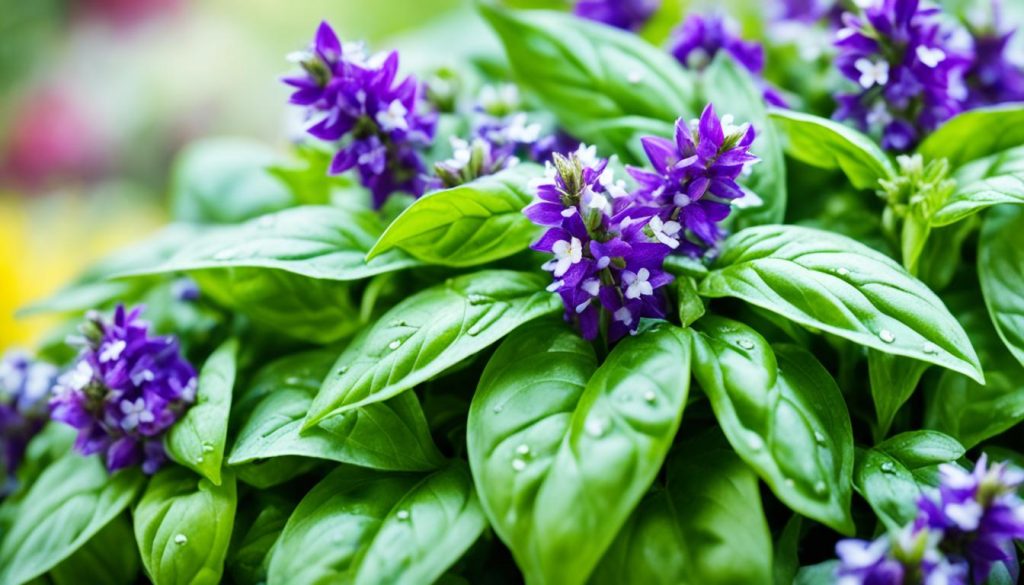
Basil has plant compounds like eugenol, citronellol, and linalool. These help fight inflammation and kill bacteria. Basil is a great way to support your health.
“Incorporating basil into your daily meals can be a simple and delicious way to boost your nutritional intake and reap the health benefits of this remarkable herb.”
Enjoy basil fresh in salads, blend it into pesto, or add it to your favorite dishes. Basil is a great choice for a healthy lifestyle. It can make your meals tasty and keep you healthy.
Preserving Basil for Year-Round Enjoyment
As summer ends, we might miss our basil plants. But, we can keep the basil’s flavor all year with simple methods.
Drying, Freezing, and Infusing Basil
Drying basil is easy. Rinse and pat the leaves dry. Put them on a baking sheet in a warm, airy spot. Soon, you’ll have dried basil to use all year.
To freeze basil, chop the leaves and fill ice cube trays with them and water or broth. Once frozen, use these basil cubes in soups and sauces for fresh flavor.
Infusing basil into oils is another great way to preserve it. This makes a tasty condiment for many dishes. Mix basil leaves with oil and let it sit for weeks. You’ll get basil-infused oil to spice up your food for months.
With these methods, you can enjoy fresh basil all year. This lets you keep its great taste and smell in your cooking.
Basil
I love cooking at home and basil always catches my eye. This herb can turn a simple dish into something amazing. It has a unique taste that ranges from sweet to peppery.
Basil makes many recipes better, from classic pesto to summer salads. It adds a special touch to my cooking. I enjoy finding new ways to use it in my dishes.
Basil takes me on a journey around the world. I love the Genovese basil for Italian dishes and the spicy Thai basil for Asian recipes. Each type has its own special taste.
I also grow my own basil and find it very rewarding. Taking care of these plants and picking their leaves is fun. With the right care, I always have fresh basil ready to use.
If you like cooking at home, try using basil more. It’s a key ingredient for making tasty dishes. Its unique taste and versatility are perfect for any kitchen.
Pairing Basil with Other Herbs and Spices
Basil’s flavor is amazing on its own. But it also pairs well with many herbs and spices. This makes cooking with basil exciting and new. By mixing it with other flavors, cooks can make dishes that really stand out.
Complementary Flavors for Basil
Basil’s taste is sweet and fresh. It goes well with rosemary’s earthy flavor, lemon’s zesty taste, and cinnamon’s warm notes. These pairings make dishes taste better and add complexity.
| Herb/Spice | Flavor Profile | Complementary Pairing with Basil |
|---|---|---|
| Rosemary | Earthy, Woody | The robust, pine-like notes of rosemary beautifully balance the sweetness of basil, creating a harmonious blend. |
| Lemon | Bright, Citrusy | The zesty, refreshing quality of lemon complements the herbaceous notes of basil, resulting in a vibrant and invigorating flavor profile. |
| Cinnamon | Warm, Spicy | The subtle warmth and earthiness of cinnamon pair perfectly with the gentle sweetness of basil, adding a cozy and comforting touch to any dish. |
By trying out basil flavor pairings and herbs and spices that go with basil, cooks can discover new tastes. They can make dishes that really show off basil’s amazing qualities.
The Allure of Basil in Italian Cuisine
Basil is a key ingredient in Italian cooking. It has a unique smell and is very versatile. This herb is a big part of many dishes loved by people all over the world.
It’s used in dishes like pesto alla Genovese and the caprese salad. Basil goes well with ingredients like garlic, olive oil, and Parmesan. This makes it a must-have in Italian cooking.
Basil has been used in Italian cooking for a long time. It comes from the Eastern Mediterranean. Over time, it became a symbol of many regional dishes.
It can be minced for sauces, added to salads, or used as a garnish. Basil’s flexibility has made it a favorite in Italian kitchens.
| Essential Basil Recipes in Italian Cooking | Key Ingredients |
|---|---|
| Pesto alla Genovese | Basil, garlic, pine nuts, Parmesan cheese, olive oil |
| Caprese Salad | Basil, tomatoes, mozzarella cheese, balsamic vinegar, olive oil |
| Margherita Pizza | Basil, tomato sauce, mozzarella cheese |
| Tomato Bruschetta | Basil, tomatoes, garlic, olive oil, balsamic vinegar |
Basil adds more than just flavor to Italian dishes. Its bright green color and delicate leaves make them look beautiful. It adds a fresh touch to many dishes.
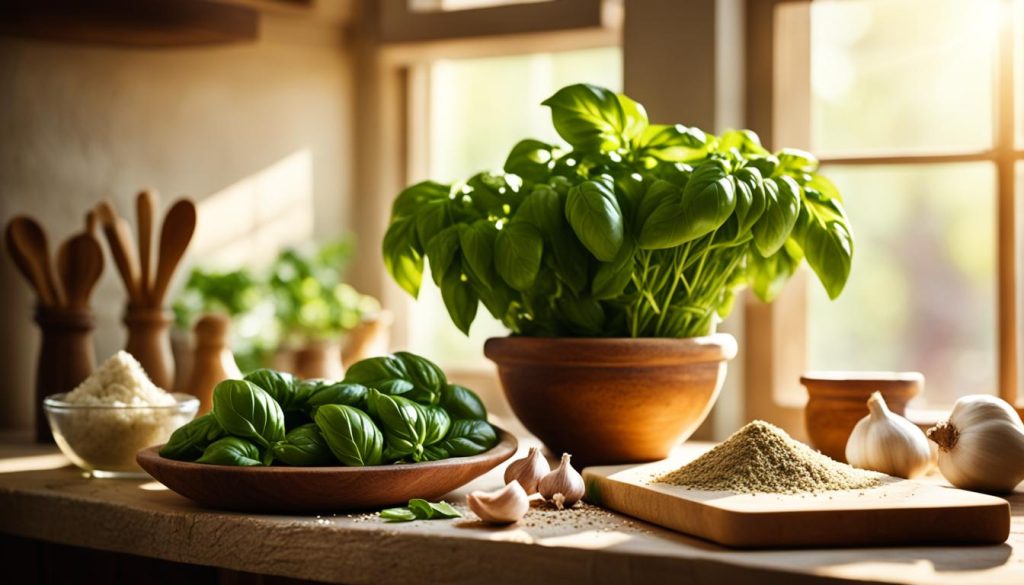
“Basil is the soul of Italian cuisine. It’s the essence that brings everything together and makes it truly Italian.”
– Anonymous Italian Chef
Basil: A Versatile and Aromatic Companion
I love using basil in my cooking because it’s so versatile and aromatic. It adds a fresh, herb-like taste to many dishes. Basil goes well with both savory and sweet foods, making soups, sauces, salads, and baked goods taste better.
Basil’s flavor is complex, with a sweet taste, a bit of pepperiness, and a strong smell. This makes it great with many foods and cooking styles. I use it in everything from Caprese salads to pesto, and even in new recipes.
Using basil in my cooking lets me be creative and try new things. It’s become a key part of my cooking. I love how it can turn simple dishes into something special.
The taste of basil is unique, with a sweet and slightly peppery flavor. It fits into many types of food and cooking methods. I add it to sauces, baked goods, and even use it as a garnish. Basil always makes my dishes taste and smell better.

